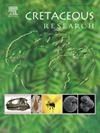Sedimentary organic matter and paleoenvironmental reconstruction of the Santana Group (Lower Cretaceous), Araripe Basin, Northeast Brazil
IF 1.9
3区 地球科学
Q1 GEOLOGY
引用次数: 0
Abstract
Depositional controls of the Santana Group in the Araripe Basin are still being debated. The main controversial subject is their marine influence and paleoenvironmental evolution. In this study, palynofacies analysis was performed on 59 samples from one core drilled at Sítio Romualdo in the Araripe Basin to investigate sedimentary organic matter. Three palynofacies associations (structureless, continental particles, and aquatic + opaque) were identified. The Santana Group consist of Barbalha, Crato, Ipubi and Romualdo formations. Based on palynofacies associations we conclude that the depositional setting of the Barbalha Formation reflects a fluvially-fed lacustrine system under oxic conditions. The Crato Formation, associated with tidal flats, coastal lakes, and lagoons within an open bay environment, represents a bayhead delta system. The Ipubi Formation corresponds to a coastal plain typical of sabkha paleoenvironments, characterized by low energy under reducing conditions, during drier climate conditions. The Romualdo Formation records mainly an estuarine paleoenvironment characterized by dysoxic to anoxic conditions. The presence of palynomorph groups typifies a late Aptian age for the Santana Group, which is based on the range of guide species marked mainly by the presence of Sergipea variverrucata biozone (P-270), as well as the occurrence of Complicatisaccus cearensis and Equisetosporites maculosus. The identification of marine palynomorphs (dinoflagellate cysts Subtilisphaera and foraminiferal test linings) are indicative of several, local marine incursions.
巴西东北部 Araripe 盆地 Santana 组(下白垩统)沉积有机质和古环境重建
对阿拉里培盆地桑塔纳组的沉积控制仍有争议。主要的争议在于其海洋影响和古环境演变。本研究对 Araripe 盆地 Sítio Romualdo 钻探的一个岩芯中的 59 个样本进行了古乐彩网分析,以研究沉积有机质。确定了三种古生物学关联(无结构、大陆颗粒和水生+不透明)。桑塔纳组由 Barbalha、Crato、Ipubi 和 Romualdo 地层组成。根据古生物化石的关联,我们得出结论,巴尔巴拉地层的沉积环境反映的是在缺氧条件下的河水湖泊系统。克拉托地层与开放海湾环境中的滩涂、沿海湖泊和泻湖有关,代表了一个湾头三角洲系统。伊普比地层对应的是典型的萨布卡古环境沿海平原,其特点是在较干旱的气候条件下,在还原条件下能量较低。Romualdo Formation 主要记录了以缺氧到缺氧条件为特征的河口古环境。根据主要以 Sergipea variverrucata 生物区(P-270)以及 Complicatisaccus cearensis 和 Equisetosporites maculosus 的出现为标志的引导物种范围,古ynomorph 群的出现典型地表明桑塔纳组的年代为晚古生代。海洋古生物(双鞭毛藻胞囊和有孔虫试片)的鉴定表明,有几次局部的海洋入侵。
本文章由计算机程序翻译,如有差异,请以英文原文为准。
求助全文
约1分钟内获得全文
求助全文
来源期刊

Cretaceous Research
地学-地质学
CiteScore
4.10
自引率
19.00%
发文量
235
审稿时长
12 weeks
期刊介绍:
Cretaceous Research provides a forum for the rapid publication of research on all aspects of the Cretaceous Period, including its boundaries with the Jurassic and Palaeogene. Authoritative papers reporting detailed investigations of Cretaceous stratigraphy and palaeontology, studies of regional geology, and reviews of recently published books are complemented by short communications of significant new findings.
Papers submitted to Cretaceous Research should place the research in a broad context, with emphasis placed towards our better understanding of the Cretaceous, that are therefore of interest to the diverse, international readership of the journal. Full length papers that focus solely on a local theme or area will not be accepted for publication; authors of short communications are encouraged to discuss how their findings are of relevance to the Cretaceous on a broad scale.
Research Areas include:
• Regional geology
• Stratigraphy and palaeontology
• Palaeobiology
• Palaeobiogeography
• Palaeoceanography
• Palaeoclimatology
• Evolutionary Palaeoecology
• Geochronology
• Global events.
 求助内容:
求助内容: 应助结果提醒方式:
应助结果提醒方式:


